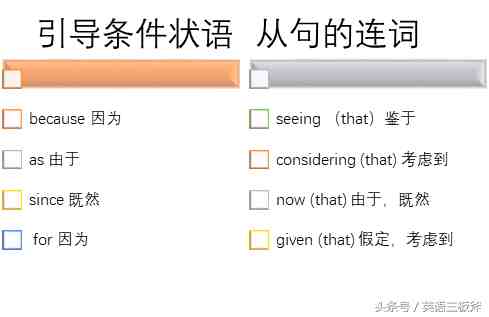原因状语从句|原因状语从句讲解
原因状语从句(原因状语从句讲解)
原因状语从句:1、定义:在句中用来说明主句原因的句子叫原因状语从句 。
2、常用引导词: because (因为), as (由于), since (既然百思特网), now (that) (既然)
3、时态:原因状语从句一般都是根据实际情况选用适当的时态 。通常是主过从过 , 主现从现 。
4、because, since和as的区别:
1) because引导的原因状语从句一般放于主句的后面 , because从句位于句首时要用逗号分开 , 放在句末时 , 可不用逗号分开 。because表示直接原因 , 语气最强 , 最适合回答why引导的疑问句 。because of 也表示原因 , 但它后面不接从句, 只能接名词, 代词或动名词 。注意:because 和so 不可同时出现在一个句子里 。
【原因状语从句|原因状语从句讲解】
① I do it because I like it. = I like it so I do it.② We went by bus because it was cheaper. = It was cheaper so we went by bus.
③ He can’t go to school because of his illness.
2) since引导的原因状语从句一般放于主句之前表示已知的、 显然的理由(通常被翻译成“既然”= now that ) , 较为正式 , 语气比because弱 。
① Since you are free today, you had better help me with my mathematics.
② Since you don't trust him, y百思特网ou should not employ him.
③ Now (that) you are grown up, you should not rely on your parents.
3) as 引导原因状语从句时表示附带说明的“双方已知的原因” , 含有对比说明的意味 , 语气比since弱 , 较为正式 , 位置较为灵活(常放于主句之前) 。
①百思特网 As it is raining, you’d better take a taxi.
② As you are tired, you had better rest.
③ I went to bed early, as I was exhausted.
4) for引导的是并列句表示原因但并不说明主句行为发生的直接原因 , 只提供一些辅助性的补充说明 , for引导的并列句只能放于主句之后并且必须用逗号将其与主句隔开 。
① He could not have seen me, for I was not there.
② He seldom goes out now, for he is very old.

- 女生|女生第一次之后还出血是什么原因
- 净值型|千万不要买净值型理财产品的原因
- 机油|机油有沉淀物什么原因
- 腊肉|腊肉吃了喉咙痛是什么原因
- 越活越年轻的根本原因,说得很透彻
- 发动机|发动机机油油泥多是什么原因
- 马桶|马桶上水有声音还特别慢什么原因
- 《骆驼祥子》:越没本事的人,越喜欢从别人身上找原因
- 猫咪|猫咪脚垫热是什么原因
- 自身原因辞职报告怎么写?
